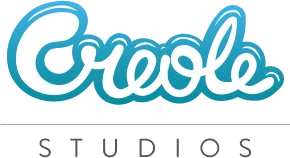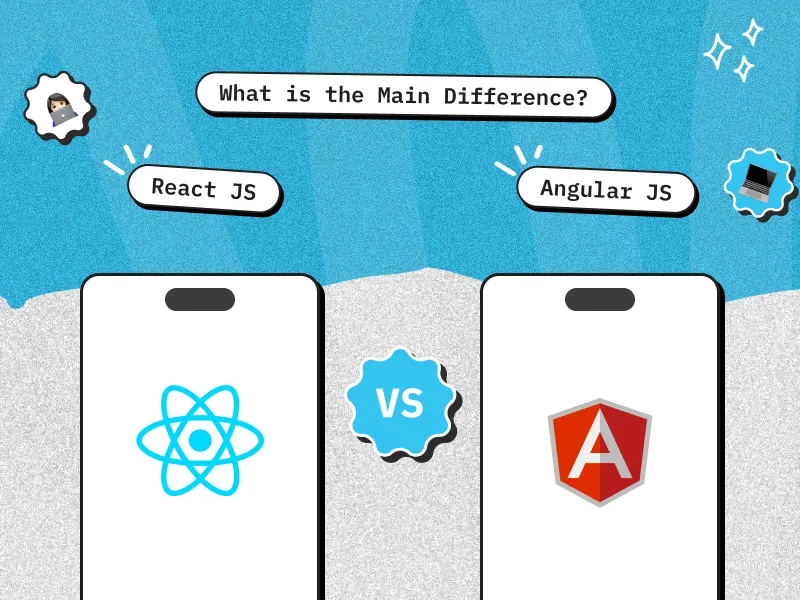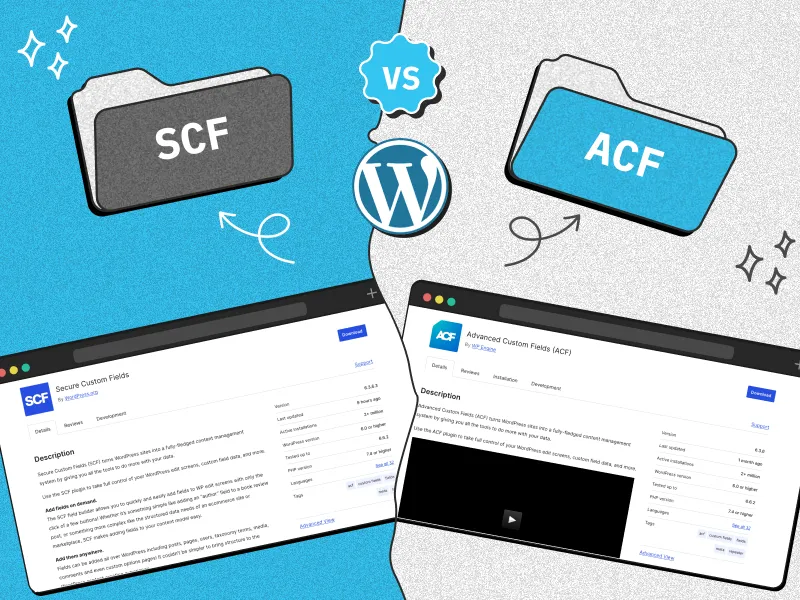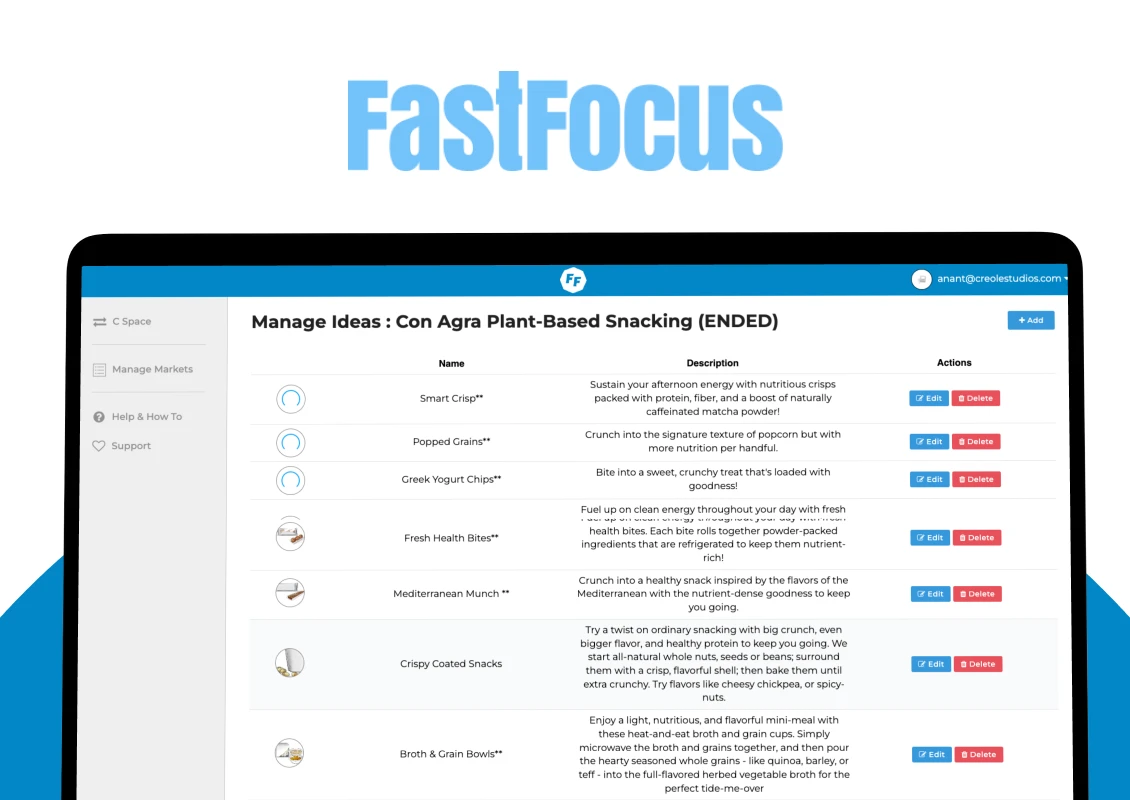Quick Summary
Choosing the right framework for your web or mobile application can significantly impact its performance, scalability, and overall user experience. Among the most debated choices are ReactJS V/s AngularJS. Both are popular, widely used JavaScript technologies, but they differ in functionality, performance, and use cases. Let’s dive into an in-depth comparison to help you decide which is better suited for your project.
Introduction
When embarking on a new project, one of the crucial decisions for developers is selecting the right framework. Among the many options available today, React and Angular stand out as two primary choices for front-end development.
Both frameworks are powerful, backed by giants like Facebook and Google, and have large, thriving communities. For businesses partnering with a web application development company, the choice between React and Angular can directly impact scalability, performance, and ease of integration.
We will explore various technical factors that could influence the success and viability of your app or product — and ultimately, your bottom line.
Right, now let’s turn our focus to the Angular/React debate. Before diving into a point-by-point comparison, here’s a quick tabular summary of the two.
What is ReactJS?
ReactJS is a popular JavaScript library developed by Facebook in 2013. It is designed for building user interfaces, particularly dynamic and interactive web applications. React’s component-based architecture simplifies the process of developing complex applications by breaking down the UI into reusable components.
Key features of ReactJS include:
- Virtual DOM: React optimizes performance by updating only parts of the DOM that have changed, resulting in a smoother user experience.
- Component-based Architecture: Reusable components make the code more manageable and facilitate collaborative development.
- One-way Data Binding: Data flows in a single direction, from the parent to the child component, which makes tracing data changes more predictable.
What is AngularJS?
Introduced by Google in 2010, AngularJS is a comprehensive JavaScript-based MVW (Model-View-Whatever) framework that facilitates web application development. AngularJS is recognized for its rich feature set and built-in tools that enhance productivity and promote the development of scalable web applications.
Key features include:
- Two-way Data Binding: AngularJS synchronizes the model with the view seamlessly, allowing for real-time updates.
- Directives: This allows developers to create custom HTML tags and extend HTML functionality.
- Dependency Injection: AngularJS manages dependencies automatically, encouraging modular development and testing.
Tech Curve
The tech curve, often referred to as the learning curve, pertains to the difficulty and time it takes for developers to learn and effectively use a particular technology or framework. When comparing Angular/React, understanding their respective tech curves is crucial for organizations and individuals deciding on which framework to adopt, particularly regarding training time and productivity. Let’s talk about the Angular first,
- Comprehensive Framework: Angular is a complete framework that handles almost all aspects of application development, including routing, state management, forms, and HTTP client utilities. The breadth of included features means there is more to learn upfront.
- TypeScript: Angular is built with TypeScript, which brings static typing to JavaScript. While TypeScript is an incredible tool for catching errors early and providing a more robust codebase, it does present an additional layer to learn especially for developers not familiar with type systems.
- Complexity: The framework has a complex architecture involving Modules, Components, Directives, Services, etc. Understanding how these pieces work together and managing them correctly can increase the learning time.
- Detailed Documentation and Strong Community: While the learning curve is steep, Angular tries to mitigate this with comprehensive documentation and a strong community. These resources are indispensable for new developers but also imply a need for significant initial learning and regular reference.
React, on the other hand, is often seen as having a more approachable initial learning curve but with complexity growing as applications scale.
- Flexible Library: React is a library that deals primarily with the view layer. It is less opinionated about how to structure an application, meaning developers can start producing with React quickly but must make decisions about other parts of their application architecture like routing and state management.
- JSX: React introduces JSX, a syntax extension for JavaScript, which mixes HTML with JavaScript. This new concept can be initially confusing for developers, but it is typically picked up quickly and leads to more readable and maintainable code.
- Ecosystem Flexibility: While React itself might be simpler to learn, the choices required to select additional libraries (like Redux for state management or React Router for navigation) can add layers of complexity. Developers must not only learn React but also become adept at integrating it with these other tools.
- Vibrant Community and Rich Set of Resources: React benefits from a very active community and a plethora of tutorials, courses, and third-party libraries, which can ease the learning process. However, the vastness of the ecosystem can also be overwhelming for newcomers.
Development Curve
Angular:
- Structured but Steep Learning Curve
Angular is a comprehensive, full-fledged framework that provides a wide array of in-built functionalities such as dependency injection, routing, form validation, and more, which can potentially accelerate the development process once these features are mastered. - Consistency and Tooling: Angular’s CLI offers powerful tools to start new projects, add different features, and run tests. This can greatly speed up development once developers are accustomed to the ecosystem.
Standardized Code: Due to its opinionated nature, Angular enforces consistency in code which can reduce the time developers spend making decisions about architecture or best practices. This is particularly beneficial in larger teams. - Initial Setup and Learning: The initial setup and steep learning curve might slow down the development at the beginning, especially for developers not familiar with TypeScript or developers who are new to the Angular ecosystem.
React:
- Flexible and Component-Based
React is a library focused on building user interfaces and offers a lot of flexibility, allowing developers to choose the additional libraries and tools they need for other parts of their application like state management and routing. - Rapid Prototyping: React’s component-based architecture allows for the reusable, encapsulated components that can speed up development once the initial architecture is set up.
Learning Curve: The learning curve for basic React itself is often considered lower than Angular, which might translate to faster ramp-up times for new developers. - Flexibility Over Configuration: React’s lack of opinionation means developers can tailor the project to their needs, potentially speeding up development. However, decisions on which third-party libraries to integrate (like Redux for state management or React Router for navigation) require additional setup and learning, which can initially slow down development.
Development Speed Comparison
- For Startups and New Projects: React might be quicker to start because of its simple setup and focused scope. It allows for fast and flexible UI development, which is ideal for companies looking to quickly iterate on user feedback.
- For Enterprise-Level Applications: Angular’s comprehensive suite of tools and features suited for large-scale applications can streamline much of the process once the development team is well-versed in its conventions, potentially making it faster in long-term, large-scale project settings.
Let’s look at the global level used of these two things, in the given images, these statistics are fetched from here.
Key observations:
1. Peaks and Declines:
- Peak Usage: React’s usage peaked around 2024, particularly in the Top 1M websites, indicating strong and sustained adoption.
- Recent Decline: A slight decline in usage is noticeable in 2024, possibly indicating the emergence of alternatives or market saturation.
2. Top Website Categories:
- React has been widely adopted across all categories, with the Top 1M websites showing the most significant usage.
- Top 100k and Top 10k websites have maintained steady and gradual growth over the years, reflecting its popularity among high-ranking websites.
3. Overall Trends:
- React experienced rapid growth from 2015 onward, with a steep incline up to 2024.
- Adoption in the Top 10k websites is relatively lower than the broader Top 1M category but still shows a stable upward trend.
4. Potential Factors Influencing Trends:
- Popularity and Features: React’s flexibility, component-based architecture, and strong developer community have contributed to its widespread adoption.
- Ecosystem: The extensive React ecosystem, including tools like Next.js, has made it a preferred choice for modern web development.
- Competition: While React remains dominant, slight declines could be influenced by rising alternatives like Svelte, SolidJS, or advancements in frameworks like Vue.js.
- Maturity: The slight dip in 2024 may reflect saturation among existing adopters rather than a loss of interest.
Key observations:
1. Peaks and Declines:
- Peak Usage: AngularJS saw its highest adoption in the Top 1M websites around 2022 before starting to decline steadily.
- Decline Period: The usage has significantly dropped across all categories post-2022.
2. Top Website Categories:
- The Top 1M websites exhibit the highest adoption of AngularJS compared to the Top 100k and Top 10k, showing its popularity among a broader range of websites rather than high-ranking ones.
- Usage in Top 10k and 100k websites remains relatively stable but consistently lower than the Top 1M category.
3. Overall Trends:
- AngularJS had a consistent growth trajectory up until 2022, with a subsequent sharp decline.
- Adoption is minimal in Top 10k websites, likely due to shifting preferences toward modern frameworks like React or Angular (the successor to AngularJS).
4. Potential Factors Influencing Trends:
- End of Support: Google officially ended long-term support for AngularJS in December 2021, leading to migration to newer frameworks.
- Emergence of Competitors: Modern frameworks like React, Vue.js, and Angular (successor to AngularJS) offer better features, performance, and community support.
- Legacy Use: The slower decline in certain categories indicates continued use in legacy systems or projects with no immediate migration plans.
Key Differences Between ReactJS and AngularJS
Understanding what is the main difference between Angular and React is crucial for selecting the right tool for your project. These are some key distinctions:
| Feature | AngularJS | ReactJS |
| Architecture | Follows MVC (Model-View-Controller) architecture, suitable for larger applications. | Follows a component-based approach, facilitating easier reuse and data handling. |
| Data Binding | Two-way data binding, updating the model and view simultaneously. | One-way data binding, providing better control and efficiency in data handling. |
| Performance and DOM Management | Manipulates the real DOM, which can degrade performance in larger applications. | Employs a virtual DOM, boosting performance by tracking changes and updating only the affected parts. |
| Learning Curve and Developer Experience | Offers a steep learning curve due to its complexity, but provides comprehensive tools within the framework. | Easier for developers to learn, offering flexibility and a straightforward approach. |
| Flexibility vs. Full Framework | A full-fledged framework with a wide range of built-in functionalities. | Provides flexibility, allowing developers to choose additional libraries and tools. |
Advantages of ReactJS
Performance Benefits:
ReactJS’s use of the virtual DOM significantly enhances performance, particularly in applications with high user interaction and frequent updates. Instead of updating the real DOM directly, React creates a lightweight copy (the virtual DOM), calculates the difference between the new and old states, and updates only the changed elements. This approach minimizes the number of costly DOM operations and enhances the speed and efficiency of the application.
- Example: Social media platforms like Facebook utilize React to handle the constant stream of posts, comments, and notifications efficiently, providing users with a seamless and fast experience.
Component Reusability:
ReactJS promotes the creation of reusable UI components, allowing developers to build components that can be used across various parts of the application or even in different projects. This not only reduces redundancy but also ensures consistency in design and functionality.
- Example: A button component designed in React can be reused in multiple parts of an application, such as in forms, modals, and navigation, maintaining a consistent look and behavior while reducing development time.
Ecosystem and Community Support:
React boasts a vast ecosystem backed by a robust community that contributes to an extensive range of libraries, tools, and resources. This active community support means that developers can find solutions to problems quickly, access numerous plugins, and benefit from a wealth of tutorials and documentation.
- Example: Developers can leverage libraries like Redux for state management, React Router for navigation, and Material-UI for pre-built components, accelerating the development process and enhancing application functionality.
Fast Rendering with Virtual DOM:
ReactJS’s virtual DOM plays a crucial role in its superior performance by minimizing the direct manipulation of the real DOM. The virtual DOM is essentially a lightweight copy of the real DOM that ReactJS uses to detect changes. When the state of a component changes, ReactJS updates the virtual DOM first, compares it with the previous version, and then updates the real DOM with only the necessary changes. This selective updating process significantly reduces the time and computational power required, leading to faster rendering and smoother user experiences.
- Example: Consider a stock market application where prices of stocks are updated every few seconds. The virtual DOM ensures that only the components displaying the updated stock prices are re-rendered, instead of the entire application. This efficient update mechanism ensures that users receive real-time data without noticeable delays, which is crucial for making timely investment decisions.
Strong Backing by Facebook:
ReactJS is developed and maintained by Facebook, one of the largest and most influential tech companies globally. This backing provides ReactJS with a stable foundation, ensuring it remains updated with the latest web development trends and practices. Facebook’s investment in ReactJS includes regular updates, new features, and performance improvements, making it a reliable and future-proof framework for developers.
- Example: Facebook’s ongoing support means that developers using ReactJS can confidently adopt it for long-term projects, knowing that the framework will continue to evolve. This backing is evident in the frequent updates and enhancements introduced, such as hooks, which simplify state management and side effects in functional components, keeping ReactJS at the forefront of modern web development.
Rich Ecosystem of Developer Tools:
ReactJS boasts a rich ecosystem of developer tools that enhance productivity and the overall development experience. These tools include debugging aids, performance analyzers, and extensions that integrate seamlessly with development environments. Among the most popular is the React Developer Tools browser extension, which allows developers to inspect and debug React components directly in the browser.
- Example: The React Developer Tools extension lets developers explore component hierarchies, props, and states, providing deep insights into the behavior of their applications. For instance, if a component isn’t rendering as expected, developers can quickly pinpoint the issue by inspecting the props and state in real-time, streamlining the debugging process and reducing development time.
Server-Side Rendering (SSR) Support:
ReactJS supports server-side rendering (SSR), a technique where the server renders the initial HTML of the application before sending it to the client. This approach improves performance, especially for complex applications, as the browser can display a fully rendered page faster. SSR also enhances search engine optimization (SEO) since search engines can index the fully rendered content more effectively.
- Example: E-commerce platforms benefit greatly from SSR, as it ensures that product pages load quickly, even on slower connections. By delivering fully rendered pages from the server, users can see product details almost immediately, improving the shopping experience and reducing bounce rates. Additionally, search engines can index these pages more efficiently, improving the site’s visibility and attracting more organic traffic.
Unidirectional Data Flow:
ReactJS follows a unidirectional data flow, meaning data flows in a single direction, from parent components to child components. This design simplifies the process of tracking and managing data changes, making applications more predictable and easier to debug. Developers can trace how data changes and predict how the UI will react to these changes, reducing the likelihood of unexpected behaviors.
- Example: In a financial dashboard that displays various metrics and reports, unidirectional data flow ensures that any change in the data source propagates predictably through the application. For instance, when a new financial report is added, the dashboard updates the relevant components in a consistent manner, making it easier for developers to identify and fix issues if the data does not display correctly. This predictability is crucial in maintaining complex applications with multiple interdependent components.
Disadvantages of ReactJS
While ReactJS offers several benefits, it also comes with a few drawbacks:
Steeper Initial Learning Curve:
Although ReactJS is simpler to grasp once the core concepts are understood, beginners often find JSX (a syntax extension that allows mixing HTML with JavaScript) and the component lifecycle challenging at first. However, mastering these can lead to creating highly dynamic and efficient applications, such as complex dashboards.
- Example: A developer new to React might struggle with understanding the component lifecycle methods, such as componentDidMount or useEffect in functional components, which are crucial for managing side effects like data fetching.
Requires Additional Libraries for a Full-stack Solution:
ReactJS is primarily focused on the view layer, meaning developers need to integrate additional libraries for functionalities like routing (React Router) and state management (Redux). This modularity provides flexibility but can lead to a fragmented tech stack that requires careful integration and management.
- Example: To build a complete application, a developer might use React for the UI, React Router for routing, Redux for state management, and Axios for making HTTP requests, each requiring its own setup and maintenance.
Advantages of AngularJS
Comprehensive Framework:
AngularJS offers a full-fledged framework with built-in solutions for common development needs, reducing the reliance on external libraries. It includes robust tools for form validation, routing, an HTTP client, and more, making it a one-stop solution for many web development requirements.
- Example: Angular’s built-in form validation allows developers to create complex form structures with validation rules, error handling, and UI feedback without needing additional plugins or libraries.
Two-way Data Binding:
AngularJS’s two-way data binding synchronizes the model and the view automatically. This feature is beneficial for real-time applications where the UI needs to reflect the latest data changes without manual intervention.
- Example: In a chat application, two-way data binding ensures that messages sent by users are instantly displayed in the chat window without needing explicit updates, enhancing the real-time communication experience.
Built-in Functionalities like Dependency Injection:
AngularJS includes dependency injection, a design pattern that simplifies managing dependencies by allowing the framework to provide components with their required dependencies.
- Example: In a large enterprise application, services like logging or authentication can be injected into various parts of the application without manually managing dependencies, promoting better modularity and easier testing.
MVVM Architecture:
AngularJS adheres to the Model-View-ViewModel (MVVM) architecture, a design pattern that separates the application logic (Model), the user interface (View), and the intermediate representation (ViewModel) that binds them. This separation of concerns leads to cleaner, more maintainable, and scalable code by isolating each layer’s responsibilities. This approach ensures that the UI can be easily modified without affecting the underlying business logic and vice versa.
- Example: In an enterprise resource planning (ERP) system, which often includes various modules such as inventory management, human resources, and finance, the MVVM architecture allows developers to work on different parts of the system independently. For instance, modifications to the human resources module’s user interface can be made without impacting the inventory management module’s data logic, promoting modularity and ease of maintenance.
Built-in Directives for Dynamic UI Elements:
AngularJS comes with a rich set of built-in directives, such as ngIf, ngFor, and ngClass, which simplify the development of dynamic and interactive UI elements. These directives allow developers to manipulate the DOM easily and create complex UI behaviors with minimal code, enhancing the user experience.
- Example: In a news application, the ngFor directive can be used to iterate over a list of articles and dynamically display them based on user preferences or trending topics. This capability allows for a personalized news feed without requiring extensive additional code. Similarly, ngIf can conditionally render elements, like showing a “Read More” button only when the article exceeds a certain length, thus creating a more interactive and user-friendly interface.
Comprehensive Testing Support:
AngularJS offers robust testing support, including tools and frameworks for both unit testing and end-to-end testing. It provides built-in utilities such as TestBed for unit testing components, services, and directives, ensuring that each part of the application functions correctly. End-to-end testing can be performed using Angular’s Protractor framework, which simulates user interactions with the application to verify its overall behavior.
- Example: Using Angular’s TestBed utility, developers can set up and execute unit tests for individual components, such as a login form, to validate that it properly handles user input and authentication. For instance, they can verify that the form correctly displays error messages for invalid inputs. With Protractor, developers can automate end-to-end testing by simulating a user logging in, navigating through the application, and performing tasks like placing an order in an e-commerce site, ensuring the entire workflow operates as expected.
TypeScript Integration:
AngularJS is built with TypeScript, a superset of JavaScript that offers features like static typing, interfaces, decorators, and improved tooling support. TypeScript’s type-checking capabilities help developers catch errors early in the development process, leading to more robust, maintainable, and scalable applications. This integration also enhances the development experience by providing better refactoring tools and autocompletion.
- Example: In a financial application, TypeScript’s static typing ensures that variables and functions are used consistently, catching type mismatches during development rather than runtime. For instance, a function expecting a number will immediately flag an error if a string is mistakenly passed, reducing bugs and potential runtime errors. This feature is crucial in financial applications where data accuracy and reliability are paramount.
CLI for Efficient Development:
AngularJS’s Command Line Interface (CLI) significantly streamlines the development process by providing a suite of commands to automate common tasks, such as generating components, services, modules, and performing builds and tests. The CLI promotes best practices and project structure consistency, speeding up development and reducing the likelihood of human error.
- Example: A developer working on a large-scale project can use the Angular CLI to quickly generate a new component for a user profile page. Instead of manually creating files and writing boilerplate code, the CLI command ng generate component user-profile automatically creates the necessary files and sets up the component’s structure, saving time and ensuring that the component adheres to Angular’s conventions.
Internationalization and Localization Support:
AngularJS provides built-in support for internationalization (i18n) and localization, allowing developers to create applications that can easily adapt to different languages and regional settings. This feature enables developers to cater to a global audience by managing language-specific content, formatting dates, numbers, and currencies according to local conventions.
- Example: An e-commerce platform targeting international markets can use Angular’s i18n tools to offer multiple language options to users. For example, the application can automatically display prices in euros for users in Europe and in dollars for users in the United States. This capability eliminates the need for separate codebases or manual configuration for each language, facilitating a seamless global user experience.
Disadvantages of AngularJS
AngularJS is a powerful framework, but it has its shortcomings:
Larger Bundle Size:
AngularJS applications tend to have larger file sizes due to the comprehensive nature of the framework. This can affect performance, especially on mobile devices or in areas with limited bandwidth. Developers often need to use techniques like lazy loading and Ahead-of-Time (AOT) compilation to mitigate these issues.
- Example: In a mobile web application, the large initial load time can be mitigated by using lazy loading to load only the necessary components at startup, improving performance and user experience.
More Complex Learning Curve for New Developers:
AngularJS’s complexity can overwhelm new developers due to its rich set of features and stringent structure. Concepts like directives, dependency injection, and templates require a deep understanding. However, once mastered, AngularJS provides a highly structured approach to building scalable applications, making it suitable for large enterprise projects
- Example: A new developer might struggle with understanding Angular’s use of templates and directives for building dynamic content, which is crucial for leveraging Angular’s full potential in creating scalable and maintainable applications.
When to Use ReactJS vs. AngularJS
Choosing between ReactJS and AngularJS depends significantly on the specific requirements and nature of your project. Each framework offers distinct advantages that cater to different types of applications, project scales, and team expertise. Here’s a more detailed look into when you should opt for ReactJS versus AngularJS, enriched with practical examples to help you make an informed decision.
When to Use ReactJS
ReactJS is an excellent choice for projects that demand high performance, flexibility, and the ability to handle frequent updates to the user interface. Its component-based architecture and virtual DOM make it particularly well-suited for dynamic and interactive web applications.
Use Cases for ReactJS:
High-Traffic Applications:
- Example: A social media platform like Facebook or Twitter.
- ReactJS’s virtual DOM ensures efficient updates and rendering, which is crucial for applications where content frequently changes, such as news feeds, live comments, or notifications.
- The component-driven nature allows developers to break down the UI into reusable components, making it easier to manage complex UIs and improve performance.
Dynamic Component Updating:
- Example: A real-time dashboard for monitoring business metrics or IoT devices.
- ReactJS excels in scenarios where the UI needs to reflect real-time data changes, such as stock market tracking apps or fitness trackers displaying real-time statistics.
- Developers can update specific components without re-rendering the entire page, enhancing the user experience and reducing load times.
Single-Page Applications (SPAs):
- Example: An e-commerce site like Shopify or a media streaming service like Netflix.
- SPAs benefit from ReactJS’s ability to update the view without requiring a full page reload, providing users with a seamless and responsive experience as they browse through products or media content.
When to Use AngularJS
AngularJS (or its modern version, Angular) is ideal for comprehensive, large-scale enterprise solutions that require a well-structured and opinionated framework. Angular’s rich feature set, including built-in services, dependency injection, and two-way data binding, simplifies the development of robust applications with complex requirements.
Use Cases for AngularJS:
Enterprise-Level Applications:
- Example: An enterprise resource planning (ERP) system or a customer relationship management (CRM) platform.
- AngularJS’s all-in-one framework approach is beneficial for developing extensive business applications that require a standardized structure and scalability.
- Its robust architecture, including modules, services, and routing, supports the creation of complex workflows and data management systems typical in enterprise solutions.
Real-Time Data Applications:
- Example: A collaborative tool like Google Docs or a real-time chat application.
- Angular’s two-way data binding allows automatic synchronization between the model and the view, making it suitable for applications where real-time data updates are crucial.
- For example, in a real-time collaborative document editing tool, any change made by one user is instantly reflected to other users, enhancing collaboration and productivity.
Progressive Web Apps (PWAs) and Mobile Applications:
- Example: A project management tool like Asana or a healthcare management system.
- Angular provides a complete solution for building PWAs and mobile applications, integrating easily with frameworks like Ionic for mobile development.
- Its built-in tools and CLI simplify the development and deployment process, ensuring a consistent user experience across web and mobile platforms.
ReactJS vs. AngularJS: A Detailed Comparison
ReactJS and AngularJS have both become pivotal tools in modern web development, each with its own set of strengths and areas of focus. Below is a detailed exploration of their differences, helping you decide which is best suited for your next project:
Popularity and Community Support
Both ReactJS and AngularJS boast extensive communities, reflecting their widespread adoption and the wealth of resources available to developers.
ReactJS:
- ReactJS has cultivated one of the largest communities in the development world. This vast ecosystem includes an array of third-party libraries, tools, and resources that make it easier for developers to enhance and customize their projects.
- The active participation in forums, GitHub repositories, and Stack Overflow discussions ensures that developers can quickly find solutions to common challenges.
- Continuous contributions from Facebook, the primary maintainer of ReactJS, along with numerous developers and companies, have solidified its standing in the industry.
AngularJS:
- AngularJS, backed by Google, also has a robust community that offers substantial support, including detailed documentation, tutorials, and regular conferences.
- Despite a slightly smaller community compared to ReactJS, AngularJS’s support base is very active and provides comprehensive guidance for its users.
- The availability of Angular CLI (Command Line Interface) tools and official libraries enriches the development experience, especially for those working within Angular’s ecosystem.
Performance Considerations
Performance is a crucial factor when selecting a framework, and both ReactJS and AngularJS handle it differently.
ReactJS:
- ReactJS excels in performance, thanks largely to its virtual DOM (Document Object Model). The virtual DOM minimizes the number of direct manipulations required on the actual DOM, leading to faster updates and rendering.
- This approach is particularly advantageous for applications that require frequent and dynamic updates, such as real-time chat applications or live data feeds.
- React’s efficient updating mechanism ensures that only the necessary components are re-rendered, improving the overall user experience and reducing load times.
AngularJS:
- AngularJS uses a real DOM, which means changes in the application require the entire DOM to be updated. This can slow down performance, especially in applications with complex data structures or numerous interactive elements.
- Despite this, AngularJS offers features like Ahead-of-Time (AOT) compilation and tree-shaking, which help optimize performance to a certain extent.
- For developers who need to manage large-scale applications, AngularJS’s built-in tools can be very beneficial, although it might not match ReactJS in raw speed for dynamic, highly interactive apps.
Use Cases and Project Types
Choosing between ReactJS and AngularJS often depends on the specific needs of your project.
ReactJS:
- ReactJS is a library focused on building user interfaces, making it an excellent choice for projects where a rich, dynamic UI is paramount.
- It is commonly used in scenarios that demand high user engagement, such as single-page applications (SPAs), social media platforms, or online marketplaces.
- React’s flexibility allows developers to integrate it with other libraries or frameworks (like Redux for state management), tailoring the development process to the project’s unique requirements.
AngularJS:
- AngularJS is a full-fledged framework that comes with everything needed to build large, complex applications, from routing to form handling and HTTP services.
- It is particularly suitable for enterprise-level applications or projects where a structured, opinionated framework can streamline development.
- The built-in capabilities of AngularJS make it an attractive choice for developers who prefer an all-in-one solution without needing to piece together various libraries.
Future Trends and Longevity
Both ReactJS and AngularJS are evolving continuously, with their respective communities and corporate backers pushing the boundaries of web development.
ReactJS:
- ReactJS’s component-driven architecture has set a trend in how modern UIs are built, influencing numerous other libraries and frameworks.
- Its continued popularity is a testament to its robustness and flexibility. Facebook’s ongoing support and the vibrant community ensure that ReactJS will remain a dominant force in web development for years to come.
- The introduction of hooks and concurrent mode in ReactJS represents significant advancements, further enhancing its efficiency and ease of use.
AngularJS:
- AngularJS, particularly its modern iteration (Angular, which is a rewrite from AngularJS), is also in a state of constant improvement. Google’s commitment to long-term support means that Angular will continue to be a reliable option for large-scale projects.
- The framework’s regular updates focus on performance enhancements, developer experience improvements, and adherence to modern web standards.
- The transition from AngularJS to Angular signifies a forward-thinking approach, ensuring that developers have access to the latest features and improvements.
Conclusion
In conclusion, the choice between AngularJS and ReactJS depends on your project’s unique needs and goals. If you’re looking for a comprehensive framework with built-in features, two-way data binding, and scalability for large-scale applications, hiring AngularJS developers would be the ideal solution. On the other hand, if you prioritize performance, flexibility, and component reusability for dynamic, high-interaction web applications, it’s best to hire ReactJS developers. By understanding your requirements and leveraging the expertise of the right developers, you can ensure a successful and efficient web development process.
Frequently Asked Questions (FAQ)
How is ReactJS different from AngularJS?
ReactJS is a library focused on UI components and offers flexibility, while AngularJS is a full framework providing numerous built-in features.
Which is better for large-scale projects, ReactJS or AngularJS?
AngularJS is better suited for large-scale projects due to its comprehensive framework, although ReactJS can be used with additional libraries.
Can I switch from AngularJS to ReactJS easily?
Transitioning to ReactJS from AngularJS can be challenging due to differing architectures, although project-specific factors can make migration easier.
Why is ReactJS considered faster than AngularJS?
ReactJS’s use of a virtual DOM allows it to efficiently update only parts of the UI, resulting in faster performance.
Is it necessary to learn both ReactJS and AngularJS?
While learning both can be advantageous, specializing in one can be more practical depending on the market demand and project requirements.











 30 mins free Consulting
30 mins free Consulting 
 10 min read
10 min read 


 Canada
Canada 
 USA
USA 






 Love we get from the world
Love we get from the world 